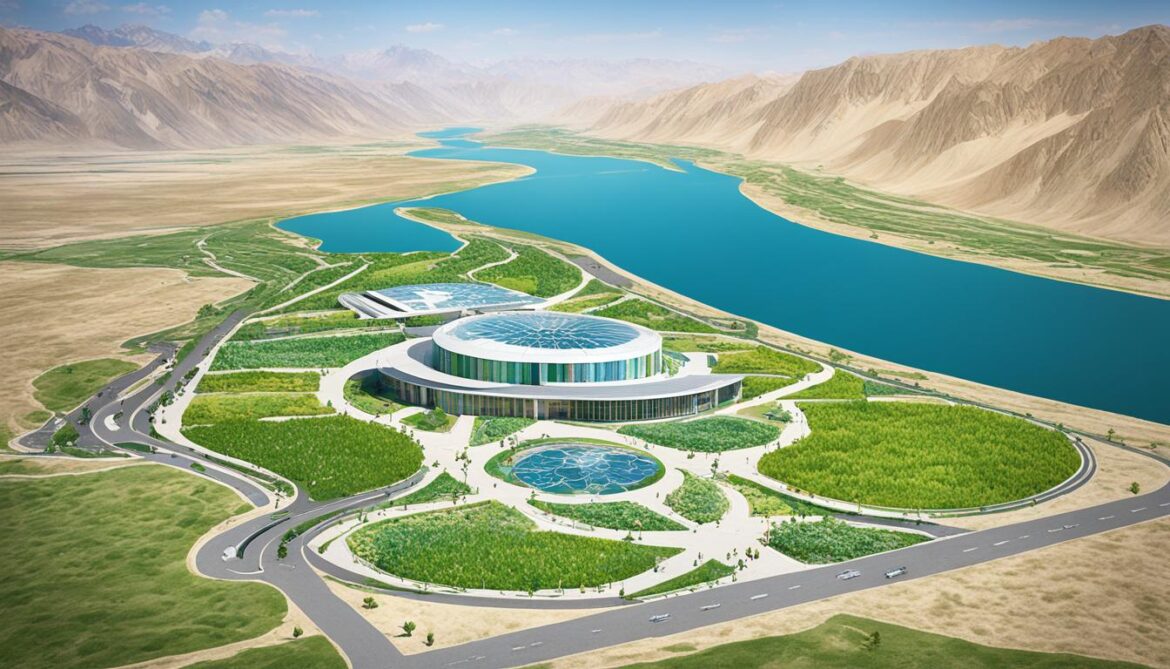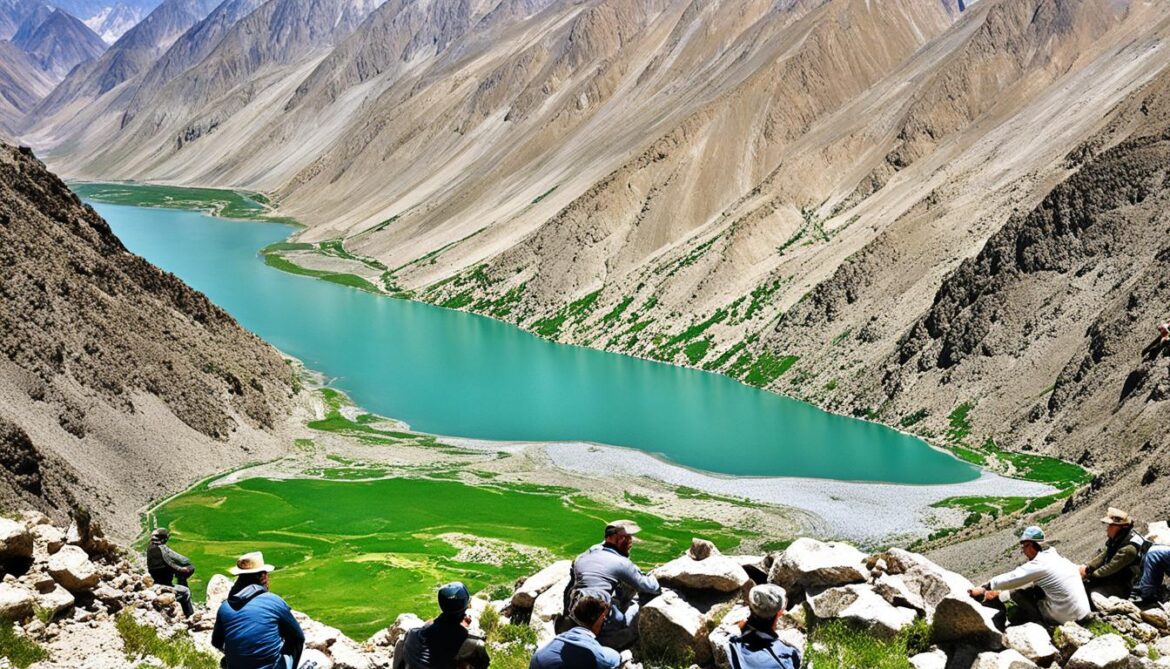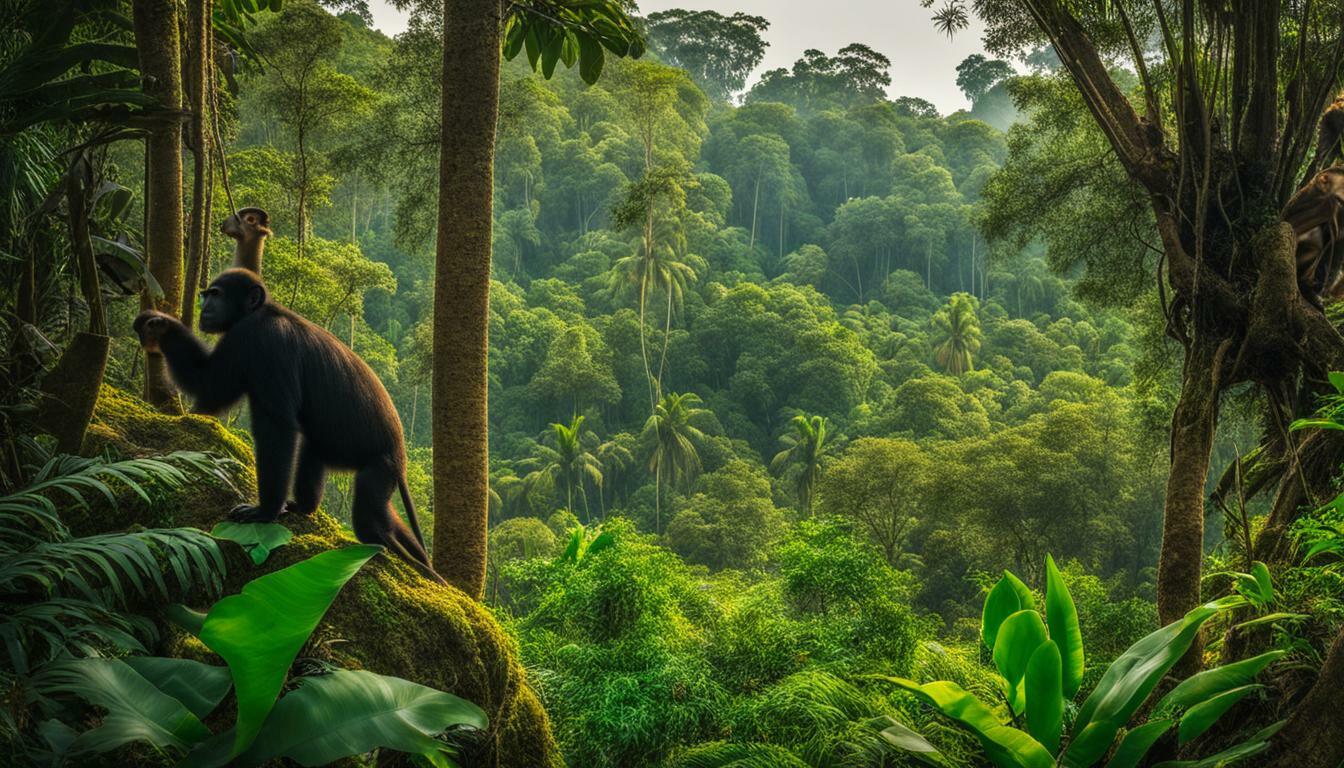Tajikistan Sacred Natural Sites and Biodiversity
Did you know that Tajikistan is home to over 80% of Central Asia’s biodiversity? This small but mighty country in Central Asia is not only known for its stunning landscapes and rich cultural heritage but also for its incredible natural diversity. Tajikistan boasts a wide range of ecosystems, including mountains, lakes, and forests, which harbor a remarkable array of plant and animal species. Protecting this unique natural heritage is crucial for the conservation of biodiversity and the sustainable future of the country.
Key Takeaways:
- Tajikistan is home to over 80% of Central Asia’s biodiversity.
- The country’s diverse ecosystems, including mountains, lakes, and forests, provide habitat for a wide range of plant and animal species.
- Protecting Tajikistan’s natural heritage is essential for the conservation of biodiversity and the sustainable development of the country.
- Sacred natural sites play a critical role in biodiversity conservation and cultural preservation.
- Tajikistan has a National Strategy and Action Plan on the Conservation and Sustainable Use of Biodiversity to guide its conservation efforts.
Importance of Sacred Natural Sites for Biodiversity Conservation
Sacred natural sites hold a special place in the realm of biodiversity conservation. These unique locations, encompassing mountains, groves, and rivers, not only serve as magnificent landscapes but also function as near-natural ecosystems that have endured the perils of environmental degradation. One cannot overlook the cultural and traditional significance attached to these sites, which has contributed to their preservation over the years.
One of the key roles that sacred natural sites play is providing safe havens for rare and endangered species. The undisturbed ecosystems found within these sites offer much-needed sanctuary for plant and animal species facing threats from habitat destruction. It is within these protected areas that these species find refuge, allowing them to thrive and contribute to the overall biodiversity of the region.
Furthermore, sacred natural sites are also potential gene pools for restoring degraded environments. These sites serve as reservoirs of biological resources, enabling the rejuvenation of ecosystems that have been impacted by human activities. By preserving the natural balance within these sites, it becomes possible to harness their genetic wealth and utilize it in ecological restoration efforts.
It is important to note that sacred natural sites hold immense cultural and spiritual value for communities. The connection between these sites and the cultural identity of the people living in proximity is significant. The preservation of these sites not only ensures the protection of biological diversity but also upholds the intangible heritage of generations. By recognizing the value of these sites, we reaffirm the importance of preserving the delicate interplay between cultural and biological diversity.
“Sacred natural sites are more than just ecosystems. They are living repositories of our cultural heritage, intrinsic to our identity and spirituality.”
– Dr. Elena Stankova, Biodiversity Conservation Expert
Combining the preservation of biodiversity with cultural heritage, sacred natural sites offer a holistic approach to environmental conservation. By recognizing their significance, we not only protect the biological resources within these sites but also contribute to the overall well-being of communities and the sustainable development of the region.
The Role of Conservation Areas in Biodiversity Preservation
Conservation areas play a crucial role in safeguarding biodiversity and maintaining the integrity of sacred natural sites. These designated areas ensure the protection of fragile ecosystems and serve as vital corridors for the movement of species. By establishing and effectively managing conservation areas, we foster the resilience of biodiversity and promote sustainable ecological practices.
National Strategy and Action Plan for Biodiversity Conservation
Tajikistan’s commitment to biodiversity conservation is exemplified through its comprehensive National Strategy and Action Plan. This strategic framework focuses on the preservation and sustainable use of biodiversity, with a specific emphasis on genetic resources, in situ and ex situ conservation measures, and ensuring biological safety throughout the country.
The National Strategy and Action Plan addresses fifteen key priorities for biological conservation in Tajikistan, reflecting the nation’s dedication to preserving its rich natural heritage. These priorities encompass a wide range of initiatives, including the creation of a national ecological network and the conservation of each unique ecosystem found within the country.
“The National Strategy and Action Plan serves as a roadmap for biodiversity conservation, providing a clear direction for the preservation and sustainable use of our biological resources. By implementing this comprehensive plan, we aim to safeguard our genetic resources, protect our diverse ecosystems, and ensure the long-term biological safety of Tajikistan,”
The Regeneration and Conservation of Genetic Resources
One of the core aspects addressed by the National Strategy and Action Plan is the regeneration and conservation of genetic resources. Genetic resources are invaluable assets that contribute to the resilience and adaptability of various species. Through rigorous conservation efforts, Tajikistan aims to protect the genetic diversity of its flora and fauna, preserving both common and rare species for future generations.
In Situ and Ex Situ Conservation Measures
In situ conservation involves the protection and management of habitats and ecosystems in their natural environment, while ex situ conservation involves the preservation of species outside their natural habitats. Tajikistan recognizes the importance of both approaches and implements a comprehensive range of in situ and ex situ conservation measures to safeguard its biodiversity. These measures include the establishment of protected areas, seed banks, and botanical gardens to ensure the survival and continuity of diverse species.
Ensuring Biological Safety
Biological safety is a fundamental component of biodiversity conservation, focusing on the prevention and management of potential risks associated with living organisms. Tajikistan’s National Strategy and Action Plan places a strong emphasis on ensuring biological safety, aiming to minimize the spread of invasive species, diseases, and other potential threats to its unique ecosystems. Through stringent biosecurity measures and proactive monitoring, Tajikistan strives to maintain the integrity and resilience of its biological systems.

The National Strategy and Action Plan serves as a guiding document that shapes Tajikistan’s approach to biodiversity conservation. With a focus on genetic resources, in situ and ex situ conservation measures, and biological safety, Tajikistan is committed to preserving its natural heritage for the benefit of present and future generations.
Implementation of the Aichi Biodiversity Targets
Tajikistan ratified the Nagoya Protocol on Access and Benefit-sharing in 2013. As part of the protocol’s implementation, agreements on the conservation of the genetic resources of wild fruit have been signed in pilot districts of the country. In situ and ex situ conservation measures, such as the creation of mother gardens and nurseries, have been implemented to conserve and utilize genetic resources. The country is also actively working towards achieving the 2020 Aichi Biodiversity Targets.
| Targets | Status |
|---|---|
| Aichi Target 1: | Terminology and understanding established |
| Aichi Target 2: | Incorporate biodiversity values into national planning processes |
| Aichi Target 3: | Reduce the direct pressures on biodiversity and promote sustainable use |
| Aichi Target 4: | Sustainable production and consumption |
| Aichi Target 5: | Reduce habitat loss, degradation, and fragmentation |
| Aichi Target 6: | Manage and sustainably use biodiversity resources |
| Aichi Target 7: | Protect areas essential for biodiversity and ecosystem services |
| Aichi Target 8: | Protect endangered species and ensure their recovery |
| Aichi Target 9: | Address Invasive Alien Species (IAS) and their control |
| Aichi Target 10: | Manage impacts of climate change on biodiversity |
| Aichi Target 11: | Establish an ecologically representative system of protected areas |
| Aichi Target 12: | Prevent the extinction of known threatened species |
| Aichi Target 13: | Genetic diversity maintained and utilized sustainably |
| Aichi Target 14: | Enhance ecosystem resilience and the contribution of biodiversity to carbon stocks |
| Aichi Target 15: | Enhance the benefits of biodiversity and ecosystem services to all |
In order to achieve these targets, Tajikistan has been implementing various strategies, including:
- Strengthening the legal framework for biodiversity conservation
- Establishing protected areas and conservation corridors
- Enhancing public awareness and education on biodiversity preservation
- Evaluating and monitoring biodiversity status and trends
- Building capacity for biodiversity research and conservation
Conservation of Genetic Resources of Wild Fruit
“Conserving the genetic resources of wild fruit is crucial for ensuring the future resilience and diversity of our ecosystems. By focusing on the preservation of these valuable resources, Tajikistan is taking a significant step towards achieving the Aichi Biodiversity Targets and promoting biodiversity preservation.”
The conservation initiatives in Tajikistan include the establishment of gene banks, where the genetic material of wild fruit species is collected, stored, and made available for future use. This ensures the conservation and sustainable utilization of genetic resources, supporting both biodiversity preservation and the livelihoods of local communities. Through these efforts, Tajikistan is contributing to the global mission of safeguarding genetic diversity and promoting sustainable development.

National Center for Biodiversity and Biosafety
The National Center for Biodiversity and Biosafety (NBBC) in Tajikistan plays a pivotal role in coordinating activities related to the UN Convention on Biological Diversity. The center is responsible for ensuring efficient coordination among various stakeholders involved in biodiversity conservation efforts.
One of the key responsibilities of the NBBC is mainstreaming the biodiversity action plan to effectively implement conservation measures. By working closely with governmental institutions, local authorities, institutions, and NGOs, the center ensures that all stakeholders are actively engaged in biodiversity conservation activities.
The NBBC serves as a central hub for information and knowledge exchange, fostering collaboration and coordination among different organizations working towards protecting Tajikistan’s rich biodiversity.
One notable task undertaken by the NBBC is the creation and maintenance of a comprehensive data bank on flora, fauna, ecosystems, and landscapes. This data bank serves as a valuable resource for researchers, policy-makers, and conservationists, supporting evidence-based decision-making and strategic planning.
The NBBC also plays a crucial role in attracting donors and securing funding for biodiversity conservation projects. By actively seeking financial support, the center ensures the sustainability of conservation efforts and the implementation of key initiatives outlined in the National Strategy and Action Plan.
Besides biodiversity conservation, biosafety is another important aspect addressed by the NBBC. The center coordinates efforts to ensure that activities related to genetic resources and biological materials are conducted in a manner that is safe and sustainable.
Coordinating Conservation for a Sustainable Future
The NBBC acts as a coordination hub, bringing together diverse stakeholders to harmonize efforts and optimize the impact of biodiversity conservation measures. By fostering collaboration and knowledge-sharing, the center strengthens the collective ability to protect and conserve Tajikistan’s rich natural heritage.

As the driving force behind the implementation of the National Strategy and Action Plan, the NBBC plays a vital role in safeguarding Tajikistan’s biodiversity for future generations. Through strategic coordination, data management, and biosafety initiatives, the center contributes significantly to the overall conservation efforts.
Strategy Management and Action Plan Implementation
A wide range of organizations and agencies are actively involved in the implementation of the National Strategy and Action Plan in Tajikistan. These include the National Center for Biodiversity and Biosafety, Ministry for Nature Protection, Tajik Forest Production Enterprise, and State Land Committee. Together, these entities work towards the successful execution of the plan, ensuring effective conservation and sustainable use of biodiversity in the country.
The National Strategy and Action Plan is supported by various financial mechanisms, which provide the necessary resources to implement conservation measures and achieve the set objectives. These financial mechanisms play a crucial role in funding activities such as biodiversity preservation, ecological research, and habitat restoration.
To assess and monitor the progress of activities outlined in the National Strategy and Action Plan, a Governmental Working Group has been established. This group works diligently to evaluate the effectiveness of implemented actions and make necessary adjustments to ensure the plan’s success. Regular evaluations help in identifying any gaps or challenges and finding appropriate solutions for continuous improvement.
Coordinating bodies, such as the National Center for Biodiversity and Biosafety (NBBC), play a key role in managing and coordinating the implementation of the National Strategy and Action Plan. The NBBC ensures that all stakeholders are actively engaged and encourages wider participation from government agencies, local communities, NGOs, and other relevant organizations. By fostering collaboration and cooperation, the NBBC promotes a holistic approach to biodiversity conservation and enhances the effectiveness of the action plan.
The NBBC organizes its work in five key directions:
- Coordination: The NBBC facilitates coordination among various stakeholders, ensuring a unified approach towards the implementation of the National Strategy and Action Plan.
- Information Management: A robust information management system is crucial for effective decision-making and monitoring. The NBBC maintains a comprehensive database on biodiversity, ecosystems, and landscapes, ensuring easy access to relevant information for all stakeholders.
- Decision-making on Biodiversity and Biosafety: The NBBC plays a vital role in providing expert advice and recommendations on biodiversity and biosafety-related matters. This helps in informed decision-making and policy formulation.
- Evaluation: Regular evaluation of the progress and impact of conservation activities is essential. The NBBC evaluates the effectiveness of the implemented actions, identifies areas for improvement, and shares recommendations for future initiatives.
- Participation and Engagement: The NBBC actively encourages wider participation and engagement from all relevant stakeholders. This inclusive approach ensures the success and sustainability of biodiversity conservation efforts.

Effective strategy management and action plan implementation are essential in achieving the goals outlined in the National Strategy and Action Plan. Through the active involvement of coordinating bodies, evaluation of activities, and wider participation, Tajikistan strives to ensure the successful conservation and sustainable use of its rich biodiversity.
NBSAP Implementing Agencies
Implementation of the National Strategy and Action Plan (NBSAP) in Tajikistan requires the efforts of various agencies and working groups. These organizations collaborate to ensure the successful execution of biodiversity conservation initiatives. The key implementing bodies involved in the NBSAP are:
Organizational Analytical Working Group
The Organizational Analytical Working Group consists of experts who evaluate the implementation of the NBSAP. Their role is to assess progress, identify challenges, and provide recommendations to enhance the effectiveness of conservation efforts.
Information-Technical Working Group
The Information-Technical Working Group plays a vital role in gathering and analyzing data related to biodiversity conservation. They collect information on flora, fauna, ecosystems, and landscapes, which helps inform decision-making processes and the development of conservation strategies.
Coordination Committee
The Coordination Committee ensures effective coordination and cooperation among all stakeholders involved in implementing the NBSAP. They facilitate communication, streamline activities, and oversee the overall progress of biodiversity conservation initiatives.
In addition to these working groups, the National Commission on Biological Safety and the Scientific Expert Council contribute their expertise to the implementation of the NBSAP. Their involvement strengthens the scientific and technical aspects of biodiversity conservation in Tajikistan.
Together, these implementing agencies and coordinating bodies play a crucial role in evaluating progress, collecting and analyzing information, coordinating activities, and supporting participating organizations. Their collaborative efforts are essential for fundraising and project implementation, ultimately contributing to the successful execution of the NBSAP and the preservation of Tajikistan’s rich biodiversity.
NBSAP Implementing Agencies
| Implementing Agencies | Description |
|---|---|
| Organizational Analytical Working Group | Evaluates NBSAP implementation, assesses progress, and provides recommendations. |
| Information-Technical Working Group | Gathers and analyzes data related to biodiversity conservation, informing decision-making processes. |
| Coordination Committee | Ensures effective coordination and cooperation among stakeholders involved in the NBSAP implementation. |
| National Commission on Biological Safety | Contributes scientific and technical expertise to biodiversity conservation efforts. |
| Scientific Expert Council | Provides expertise and advice on biodiversity conservation initiatives. |

Case Studies on Sacred Natural Sites and Biodiversity Conservation
Multiple case studies from different countries have shed light on the significance of sacred natural sites in the realm of biodiversity conservation. These case studies specifically delve into the conservation efforts pertaining to sacred mountains, forests, and various ecosystems, while also exploring how local knowledge and traditional beliefs contribute to the preservation of biodiversity.
One example is the renowned Mijikenda Kaya Forests in Kenya. These sacred sites serve as crucial habitats for a diverse range of plant and animal species, playing a vital role in the overall conservation of the region’s biodiversity. Moreover, their cultural and historical importance enhances their significance as sacred natural sites.
In the Himalayas, the Sacred Beyuls hold immense cultural and spiritual value for the local communities. These sites encompass pristine mountain landscapes and are home to numerous rare and endangered species. The preservation of the Sacred Beyuls not only safeguards their biodiversity but also ensures the continuation of traditional practices and beliefs.
Other case studies focus on sacred sites in West Timor, where the interconnection between cultural heritage and biodiversity conservation is evident. These sites, which are deeply ingrained in the local culture, have become sanctuaries for threatened plant and animal species, thus warranting their protection. By embracing the holistic approach of integrated conservation, these case studies amplify the call for the safeguarding of both cultural and biological diversity.

In conclusion, case studies on sacred natural sites and biodiversity conservation highlight the irrefutable link between cultural heritage and the preservation of natural ecosystems. Recognizing and protecting these sacred sites not only fosters the conservation of biodiversity but also safeguards traditions and promotes sustainable development.
Conclusion
Tajikistan’s sacred natural sites play a vital role in preserving the nation’s unique biodiversity. Through the implementation of the National Strategy and Action Plan on the Conservation and Sustainable Use of Biodiversity, Tajikistan demonstrates its commitment to biodiversity conservation. These efforts, combined with the country’s active pursuit of the Aichi Biodiversity Targets, further strengthen its conservation initiatives.
The establishment of the National Center for Biodiversity and Biosafety, along with the involvement of various implementing agencies and coordinating bodies, provides a solid foundation for biodiversity preservation. By recognizing the importance of sacred natural sites and integrating cultural and biological diversity, Tajikistan contributes not only to its own sustainable development but also to the global goal of environmental preservation.
By safeguarding its sacred natural sites, Tajikistan safeguards its natural heritage and ensures a thriving ecosystem for future generations. The preservation of these sites is not only crucial for the protection of diverse flora and fauna but also for the cultural identity and spiritual significance they hold. Tajikistan’s commitment to biodiversity conservation sets an example for other nations to follow, inspiring collective action for the preservation of our planet’s natural treasures.








